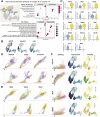Dissecting mechanisms of chamber-specific cardiac differentiation and its perturbation following retinoic acid exposure
- PMID: 35686629
- PMCID: PMC9340554
- DOI: 10.1242/dev.200557
Dissecting mechanisms of chamber-specific cardiac differentiation and its perturbation following retinoic acid exposure
Abstract
The specification of distinct cardiac lineages occurs before chamber formation and acquisition of bona fide atrial or ventricular identity. However, the mechanisms underlying these early specification events remain poorly understood. Here, we performed single cell analysis at the murine cardiac crescent, primitive heart tube and heart tube stages to uncover the transcriptional mechanisms underlying formation of atrial and ventricular cells. We find that progression towards differentiated cardiomyocytes occurs primarily based on heart field progenitor identity, and that progenitors contribute to ventricular or atrial identity through distinct differentiation mechanisms. We identify new candidate markers that define such differentiation processes and examine their expression dynamics using computational lineage trajectory methods. We further show that exposure to exogenous retinoic acid causes defects in ventricular chamber size, dysregulation in FGF signaling and a shunt in differentiation towards orthogonal lineages. Retinoic acid also causes defects in cell-cycle exit resulting in formation of hypomorphic ventricles. Collectively, our data identify, at a single cell level, distinct lineage trajectories during cardiac specification and differentiation, and the precise effects of manipulating cardiac progenitor patterning via retinoic acid signaling.
Keywords: Cardiac development; Cardiac organoid; Cardiac progenitor; Mouse; Retinoic acid; Single cell RNA-sequencing.
© 2022. Published by The Company of Biologists Ltd.
Conflict of interest statement
Competing interests R.S. is Vice President of Sema4. Since June 1 2021, M.P.L. has been an employee of Roche. All other authors declare no competing or financial interests.
Figures







References
-
- Bardot, E. S., Jadhav, B., Wickramasinghe, N., Rezza, A., Rendl, M., Sharp, A. J. and Dubois, N. C. (2020). Notch signaling commits mesoderm to the cardiac lineage. BioRxiv 2020.02.20.958348. 10.1101/2020.02.20.958348 - DOI
Publication types
MeSH terms
Substances
Grants and funding
LinkOut - more resources
Full Text Sources
Molecular Biology Databases

